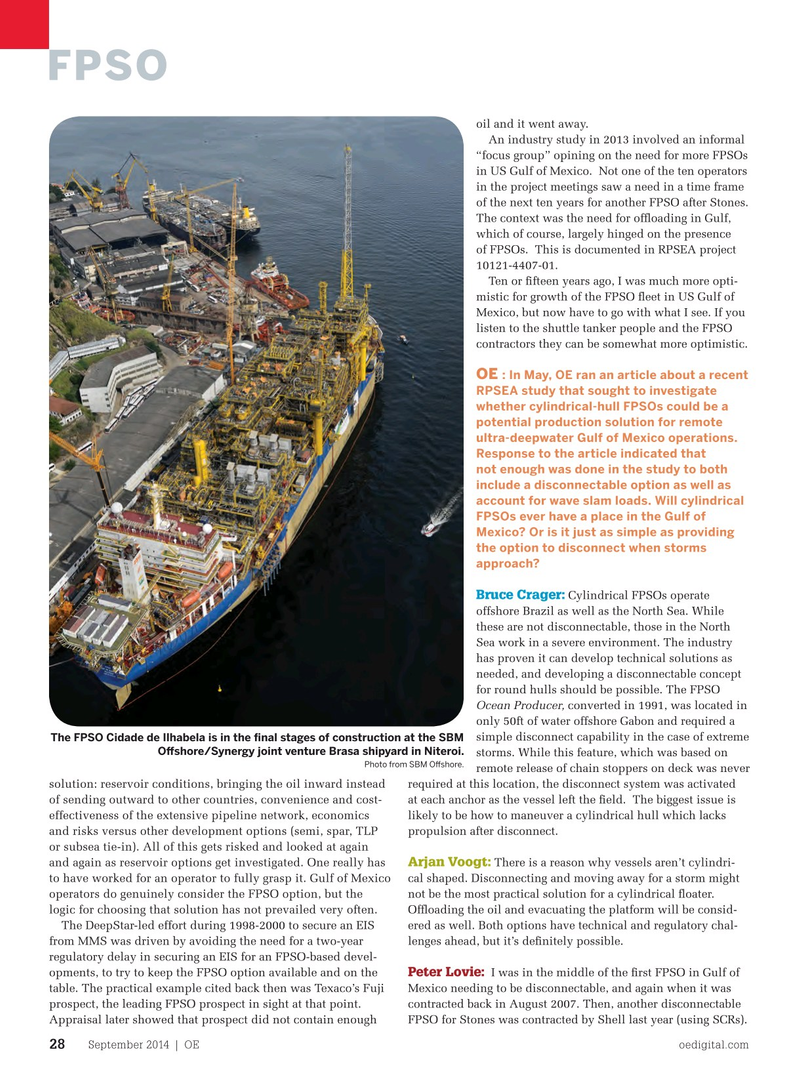
Page 26: of Offshore Engineer Magazine (Sep/Oct 2014)
Read this page in Pdf, Flash or Html5 edition of Sep/Oct 2014 Offshore Engineer Magazine
FPSO oil and it went away.
An industry study in 2013 involved an informal “focus group” opining on the need for more FPSOs in US Gulf of Mexico. Not one of the ten operators in the project meetings saw a need in a time frame of the next ten years for another FPSO after Stones.
The context was the need for offoading in Gulf, which of course, largely hinged on the presence of FPSOs. This is documented in RPSEA project 10121-4407-01.
Ten or ffteen years ago, I was much more opti- mistic for growth of the FPSO feet in US Gulf of
Mexico, but now have to go with what I see. If you listen to the shuttle tanker people and the FPSO contractors they can be somewhat more optimistic.
OE : In May, OE ran an article about a recent
RPSEA study that sought to investigate whether cylindrical-hull FPSOs could be a potential production solution for remote ultra-deepwater Gulf of Mexico operations.
Response to the article indicated that not enough was done in the study to both include a disconnectable option as well as account for wave slam loads. Will cylindrical
FPSOs ever have a place in the Gulf of
Mexico? Or is it just as simple as providing the option to disconnect when storms approach?
Bruce Crager: Cylindrical FPSOs operate offshore Brazil as well as the North Sea. While these are not disconnectable, those in the North
Sea work in a severe environment. The industry has proven it can develop technical solutions as needed, and developing a disconnectable concept for round hulls should be possible. The FPSO
Ocean Producer, converted in 1991, was located in only 50ft of water offshore Gabon and required a simple disconnect capability in the case of extreme
The FPSO Cidade de Ilhabela is in the fnal stages of construction at the SBM
Ofshore/Synergy joint venture Brasa shipyard in Niteroi. storms. While this feature, which was based on
Photo from SBM Ofshore.
remote release of chain stoppers on deck was never solution: reservoir conditions, bringing the oil inward instead required at this location, the disconnect system was activated of sending outward to other countries, convenience and cost- at each anchor as the vessel left the feld. The biggest issue is effectiveness of the extensive pipeline network, economics likely to be how to maneuver a cylindrical hull which lacks and risks versus other development options (semi, spar, TLP propulsion after disconnect.
or subsea tie-in). All of this gets risked and looked at again
Arjan Voogt: and again as reservoir options get investigated. One really has There is a reason why vessels aren’t cylindri- to have worked for an operator to fully grasp it. Gulf of Mexico cal shaped. Disconnecting and moving away for a storm might operators do genuinely consider the FPSO option, but the not be the most practical solution for a cylindrical foater. logic for choosing that solution has not prevailed very often. Offoading the oil and evacuating the platform will be consid-
The DeepStar-led effort during 1998-2000 to secure an EIS ered as well. Both options have technical and regulatory chal- from MMS was driven by avoiding the need for a two-year lenges ahead, but it’s defnitely possible.
regulatory delay in securing an EIS for an FPSO-based devel-
Peter Lovie: I was in the middle of the frst FPSO in Gulf of opments, to try to keep the FPSO option available and on the
Mexico needing to be disconnectable, and again when it was table. The practical example cited back then was Texaco’s Fuji contracted back in August 2007. Then, another disconnectable prospect, the leading FPSO prospect in sight at that point.
Appraisal later showed that prospect did not contain enough
FPSO for Stones was contracted by Shell last year (using SCRs).
September 2014 | OE oedigital.com 28 026_0914_FPSO1_Roundtable.indd 28 8/21/14 2:27 PM

 25
25

 27
27